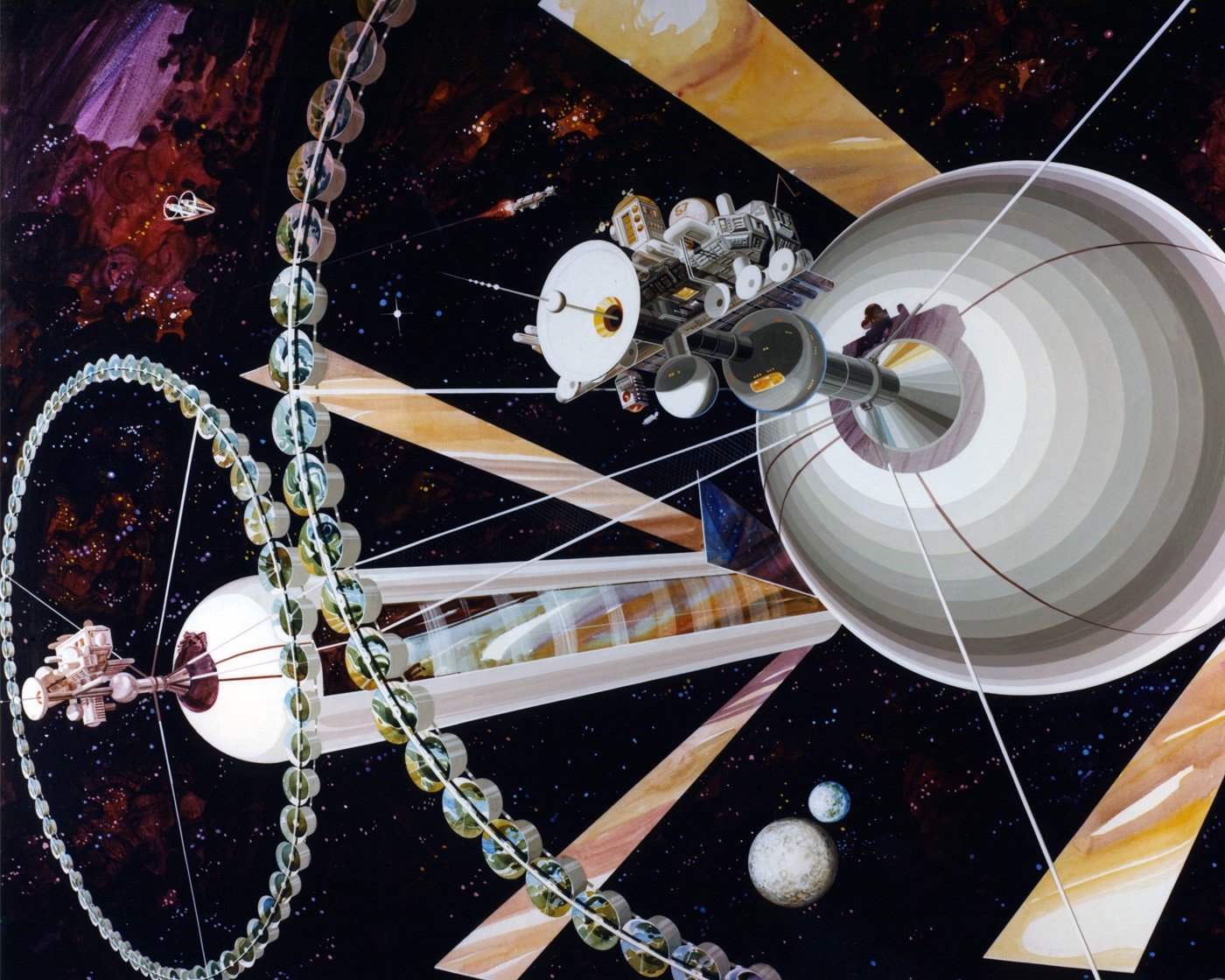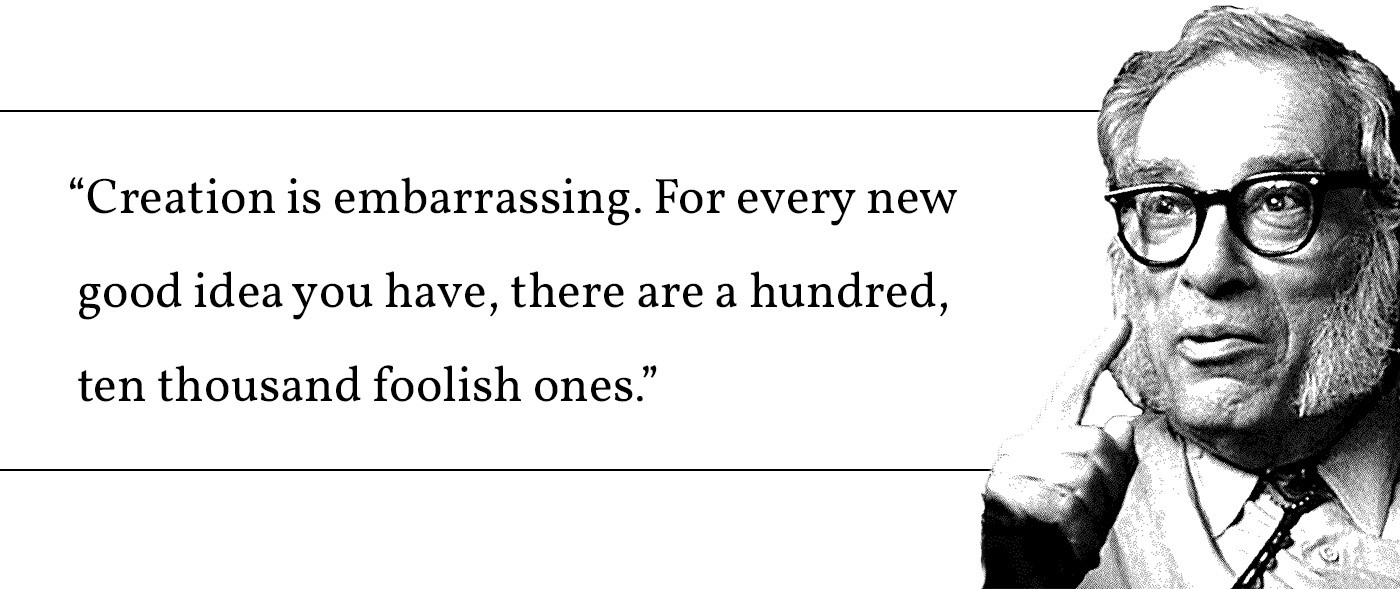January 19, 2015

Brainstorming Advice from a Long Lost Isaac Asimov Letter
“The world in general disapproves of creativity, and to be creative in public is particularly bad.” — Isaac Asimov
When a writer like Isaac Asimov talks about creativity I take note. I love hearing how prolific artists generate ideas. A tweet brought my attention to a lost letter about creativity written by Isaac Asimov from 1959. It is a remarkable document and in this post I want to highlight several quotes from Asimov’s letter that resonated with me. I encourage you to read the entire letter on MIT Technology Review but here are my favorite parts with my additional commentary…
First a little background. Asimov’s essay was the result of an invitation to participate in brainstorms for a US government defense project. Asimov calls the brainstorm a “cerebration session.” Keep that term in your back pocket next time you want to make your next meeting sound important. Anyway, the purpose of the sessions were “to elicit the most creative approaches possible for a ballistic missile defense system.” In other words, if the government was going to have any chance at stopping incoming missiles they needed to get creative. Why wouldn’t you want advice from a sci-fi author?
We should be careful when comparing these 1959 sessions with the brainstorm charades of modern corporate America. Perhaps the government of the 1950’s wasn’t as zombie-infested as it is today. Perhaps they legitimately recognized that creativity was lacking in their research and they solicited help from artists. It could have happened that way, right? Or perhaps it wasn’t an appreciation of art as much as a yearning for the sci-fi weaponry found in Asimov’s writing. Regardless, whether they knew it or not, Asimov really was an ideal person to talk to about creativity. Like so much great art, Asimov’s writing was rooted in a profound scientific understanding married with a complete mastery of his craft.
If anyone could squeeze creativity out of a bunch of bureaucratic lemons it was Asimov. Still, Asimov understood his audience and how difficult it would be to get them in a creative frame of mind. He wrote,
“Joviality, the use of first names, joking, relaxed kidding are, I think, of the essence — not in themselves, but because they encourage a willingness to be involved in the folly of creativeness… Yet your company is conducting this cerebration program on government money. To think of congressmen or the general public hearing about scientists fooling around, boondoggling, telling dirty jokes, perhaps, at government expense, is to break into a cold sweat.”
That could explain why, ultimately, Asimov excused himself from the government project, leaving only this essay as a map that might point them in the direction of creative discovery. I can’t help but wonder if he sensed the unlikelihood that the group could really embrace the challenge that true creativity represents. Perhaps that is what he meant when he wrote,
“The world in general disapproves of creativity, and to be creative in public is particularly bad.”
Reading those words in 2015 our first reaction might be to challenge this statement. Today we praise creativity! Or do we? We certainly pay it lip service, but I doubt that creativity is any easier today than it was half a century ago. This may surprise you, but your great idea will be met with opposition. You can create your art in public, but don’t count on applause. Instead, you should prepare for a zombie mob that hungers to tear your work limb from limb.

When I wrote Art of the Living Dead last year I described the creative process as an apocalyptic battle. The final third of my book attempts to identify five ingredients for creativity. It was uplifting to hear Asimov’s comments regarding each of these ingredients. They are (spoiler alert) space, time, trust, play and inspiration. Here is what Asimov had to say about these topics.
Creativity Ingredient 1: Space
“My feeling is that as far as creativity is concerned, isolation is required… The presence of others can only inhibit this process, since creation is embarrassing… The optimum number of the group would probably not be very high. I should guess that no more than five would be wanted.”
Asimov knew that creativity requires space. It is most effective when done alone, but if you keep your group small, collaboration might be beneficial. There is a chance that multiple brains are better than one. Asimov explains,
“However, if one person mentions the unusual combination of A-B and another the unusual combination A-C, it may well be that the combination A-B-C, which neither has thought of separately, may yield an answer.”
The location of the brainstorming is important, too. It must be a location that encourages discussion. Asimov recommends,
“For this purpose I think a meeting in someone’s home or over a dinner table at some restaurant is perhaps more useful than one in a conference room.”
Creativity Ingredient 2: Time
“The creative person is, in any case, continually working at it… For every new good idea you have, there are a hundred, ten thousand foolish ones, which you naturally do not care to display.”
You can’t put creativity on a deadline. You need the time to wrestle with the ideas that, at first glance, seem outlandish. Uncertainty can be unbearable and we often rush to decisions just to avoid the discomfort. This reminds me of a quote from John Cleese where he says,
“Look, Babycakes, I don’t have to decide ‘til Tuesday, and I’m not chickening out of my creative discomfort by making a snap decision before then, that’s too easy.”
That quote comes from Cleese’s fantastic speech on creativity in 1991 which echoes many of the themes I present here. I highly recommend seeking out his video, it’s fantastic.
Creativity Ingredient 3: Trust
“…creation is embarrassing…”
“For every new good idea you have, there are a hundred, ten thousand foolish ones, which you naturally do not care to display.”
“First and foremost, there must be ease, relaxation, and a general sense of permissiveness. The world in general disapproves of creativity, and to be creative in public is particularly bad. Even to speculate in public is rather worrisome. The individuals must, therefore, have the feeling that the others won’t object.”
The idea that creation is embarrassing is an interesting statement that deserves some reflection. I can’t remember ever hearing it described that way, but I tend to agree. When confronted with a legitimately new idea most people’s response is not embrace. They will probably be polite, but in their head they are struggling with feelings of mockery, ridicule, and disgust for the foreign concept. That’s because the natural response to the truly incredible is incredulity. You either have to create an environment of trust, or be willing to endure embarrassment and hope you can win support.
Asimov’s observation that “being creative in public is bad” sounds old fashioned at first, like rules prohibiting women from wearing pants or forbidding elbows on the table. Creativity isn’t something civilized people do. I don’t think this is purely a symptom of Asimov’s time, however. Today we are just as guilty of forbidding creativity outside of specially defined locations. Creativity is only expected of people with certain job titles. We literally split the population in half believing myths of right-brain or left- brain people. Force a self-described left-brainer to attend a brainstorm session where there isn’t trust and the main emotion they will experience is embarrassment.
Creativity Ingredient 4: Play
“For best purposes, there should be a feeling of informality. Joviality, the use of first names, joking, relaxed kidding are, I think, of the essence — not in themselves, but because they encourage a willingness to be involved in the folly of creativeness.”
I love that phrase, “the folly of creativeness.” It explains why children are so naturally creative, they are at ease in a state of play. Folly isn’t encouraged in adults. So we bring nerf guns and bean bags to our brainstorm sessions hoping to recreate the feeling of when we were kids, the time when we still believed anything was possible. I am all for injecting some fun into our meetings, but as Asimov notes, the creative devices can’t be forced, they need to develop naturally from the group.
“If thoroughly relaxed, free of responsibility, discussing something of interest, and being by nature unconventional, the participants themselves will create devices to stimulate discussion.”
Creativity Ingredient 5: Inspiration
“(The creative person’s) mind is shuffling his information at all times, even when he is not conscious of it. The famous example of Kekule working out the structure of benzene in his sleep is well-known.”
If you don’t know the story of Friedrich Kekule (I didn’t), he was an organic chemist who invented the notation that we used in chemistry class to map out complex molecules. Kekule’s breakthrough came to him in a dream where a snake swallowed its own tail. It is a wonderful example of how unpredictable inspiration is. You never know how or when it will hit you.
In Art of the Living Dead I tell the story of Robert Goddard, the father of modern rocketry. Similar to Kekule’s dream, Goddard’s inspiration came to him in a vision when he was seventeen. Goddard described it like this,
“I climbed a tall cherry tree and… as I looked towards the fields at the east, I imagined how wonderful it would be to make some device which had even the possibility of ascending to Mars… I was a different boy when I descended the tree.”
An abundance of space, time, trust, and play can’t guarantee success, if you lack inspiration. Without it you can’t begin. Waiting around for it to hit you can be excruciating. You can cram all the creative people you know in a room, but there is no guarantee that inspiration will attend your brainstorm.
Thanks for reading. Be sure to check out Part 2 of this post where Asimov talks about Fame, Fortune, and Creative Breakthrough, the false ingredients that can poison a well-intentioned creative environment.
Previous: The Heroes Behind Healthcare.gov